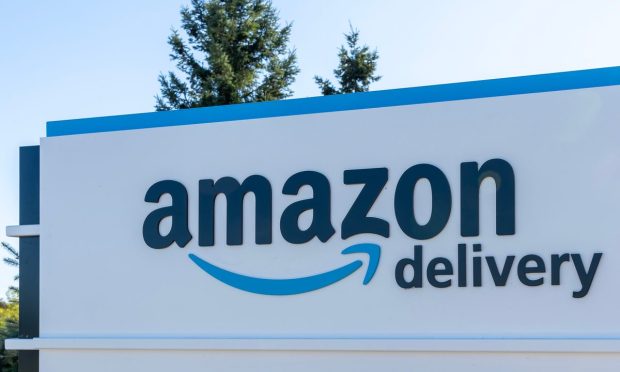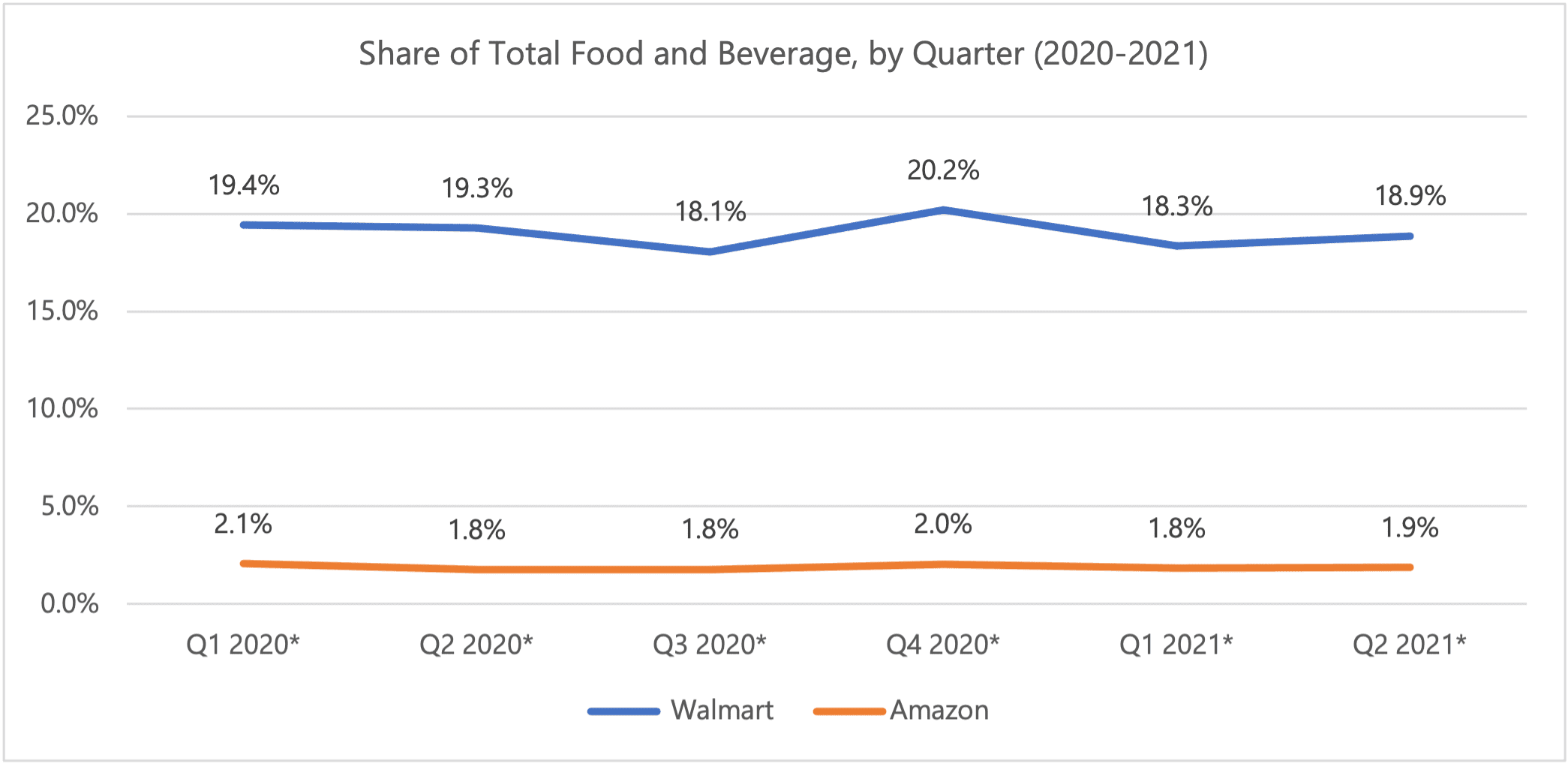AMZN vs WMT Weekly: The Logistics Arms Race Continues, and so Do Grocery Fights

The past several weeks have seen a sort of third-party logistics one-upmanship between Amazon and Walmart, culminating in this week’s report that Amazon has begun shipping cargo for outside customers to compete with UPS and FedEx.
Full story: Amazon Ships Outside Cargo to Compete with UPS, FedEx
Though Amazon doesn’t appear to be trying to replicate all the services offered by UPS and FedEx — one analyst told CNBC that Amazon is “cherry-picking their routes” and only delivering the parcel sizes they want to deliver — the retail giant is now shipping 72% of its own goods and has quietly begun transporting cargo for the U.S. Postal Service.
Amazon last month opened a $1.5 billion Amazon Air Hub in Kentucky and announced it was expanding same-day delivery service to six new cities. The company this week also opened four new last-mile delivery stations in Virginia and Maryland; its global transportation network includes 400,000 drivers, 40,000 trucks, 30,000 vans and over 70 planes.
Outside merchants already enjoy some shipping services from Amazon through its Amazon Multi-Channel Fulfillment service, which offers packing and delivering services to eCommerce merchants that include Shopify, Etsy and even Walmart.
Walmart, for its part, last month rolled out a new white-label, last-mile delivery service in the U.S. to help retailers secure local transport needs and meet delivery demands. Walmart GoLocal was developed from the box store giant’s own ability to scale delivery capabilities for its customers through its Spark Driver platform. The company’s delivery network currently reaches nearly 70% of the U.S. population, a share that is growing as Walmart continues to invest in drones, vehicles and market fulfillment centers.
Providing POS
Amazon’s secretive Project Santos team is reportedly working on a point-of-sale (POS) solution for third-party retailers that is intended to compete with Shopify, PayPal and others, a signal that Amazon may be looking to pull more small and medium-sized businesses (SMBs) into its ecosystem.
The proposed POS, first reported by Business Insider, can reportedly process transactions online and in physical stores and can provide data analytics on inventory and other business functions. They system can also offer Amazon checkout options and links to the company’s Prime services, palm identification system and Flex delivery.
Read: Amazon’s Project Santos Developing SMB POS to Rival Shopify, PayPal
To be sure, the proposed POS system would face stiff competition from established offerings by Shopify, PayPal, Square and Fiserv’s First Data, but Amazon also has the advantage of holding nearly 50% of all eCommerce sales in the U.S. By adding a POS solution, Amazon may be able to attract even more sellers to its marketplace while improving its relationships with those it already has.
Bolstering the Grocery Lead
Walmart — which remains the world’s largest grocer — said this week it would be partnering with media giant Meredith Corp. to create shoppable ads that allow consumers who interact with content to add ingredients directly to their Walmart shopping carts.
See: Walmart Partners With Meredith for AI-Informed Contextual Grocery Commerce
The partnership will utilize the two companies’ data analytics capabilities to make recommendations informed by artificial intelligence (AI), as well as visual search tools and a “shoppable bookazine” of 30-minute meals. The partnership also includes a social commerce aspect, wherein Allrecipes videos will become shoppable via Walmart with ads on TikTok, as well as a voice ordering feature through Google Assistant.
Walmart has been leaning heavily into contextual commerce to bolster its grocery offerings even as it retains a nearly 10-to-1 lead over Amazon in the category according to PYMNTS data. Last month, Walmart partnered with cooking app SideChef to release a series of five shoppable recipes; and the retailer also has a partnership with the creators of Netflix’s Waffles + Mochi that features games, videos and recipes that guide children and parents to Walmart’s eCommerce offerings.
In the second quarter, Walmart had almost 19% of U.S. food and beverage sales while Amazon saw just under 2% — approximately the same shares each company had at this point last year, according to PYMNTS data.

‘Just Walk Out’ Walks Into Whole Foods
Two new Whole Foods Market locations set to open next year will be equipped with Amazon’s cashierless “Just Walk Out” technology, allowing consumers to enter the store with a credit card and leave without stopping at a checkout line when they’re done shopping.
Dilip Kumar, Amazon’s vice president of physical retail and technology, said in a blog post that the technology, which automatically detects which items people keep and tracks everything in a virtual cart, “is made possible by a combination of computer vision, sensor function and deep learning.”
Read more: Amazon to Pilot ‘Just Walk Out’ Tech at Whole Foods Locations
Amazon bought Whole Foods in 2017 for $13.7 billion and has since tried to make the most of the acquisition in order to compete with Walmart, lowering prices and using Whole Foods locations to expand grocery delivery service. Amazon first launched cashierless technology in 2018 at its Amazon Go stores before expanding it to Amazon Fresh locations. More recently, the company started offering the technology to other stores as a business-to-business service.
The move with Whole Foods is likely meant to show other merchants that consumers will still use Just Walk Out even when “Amazon” isn’t on the brand name, but by placing the technology only in two new stores, Amazon may also be displaying how difficult it could be to scale. The amount of technology necessary for Just Walk Out likely requires a significant investment from retailers, which some may balk at unless new construction is already underway.
Walmart has also been dabbling with cashierless stores, and last month opened its second all-self-checkout retail location in Plano, Texas. The Arkansas-based box store giant opened its first cashierless superstore in its home state last year, but the Plano market is over three times larger than Fayetteville, Arkansas, marking a potentially important test for the concept.
According to PYMNTS research conducted in collaboration with Toshiba, 34% of consumers used self-checkout during their most recent retail purchase and 33% used self-checkout during their most recent grocery purchase. The most common reason for choosing self-checkout is that it’s faster than waiting on a cashier, with 66% of consumers responding this way.
See the data: Consumers Want Self-Service Checkout Options But Rarely Get to Use Them
